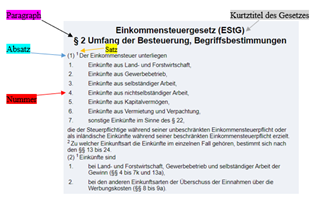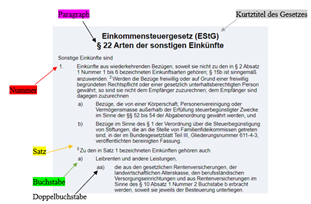Citation Guide - Germany
Country Profile
Germany is a democratic, federal republic made up of 16 States (Länder). The German Constitution, the Basic Law (Grundgesetz) of 1949 lost its “temporary” status on October 3, 1990, when the five states of the former German Democratic Republic (Deutsche Demokratische Republik) joined the unified German federation. Germany’s legal system is based on a civil law tradition.
In Germany’s federal structure, most of the legislative power is concentrated at the national level, while administrative, judicial, and enforcement functions are exercised principally at the state level. Executive responsibilities on the federal level lie principally with the Federal Government (Bundesregierung), which is headed by the Chancellor (Bundeskanzler). The Chancellor is elected by the Bundestag. The Federal President (Bundespräsident), the official head of state, is elected for a five-year term—with the possibility of reelection for a consecutive term—by a Federal Convention (Bundesversammlung) consisting of equal numbers of members of the Lower House of Parliament (Bundestag) and members elected by the parliaments of the individual states. The President’s duties are primarily ceremonial.
The Constitution vests the legislative power in a bicameral parliament, consisting of the Lower House of Parliament, whose members are directly elected by the people every four years, and the Senate (Bundesrat), who consists of members of the state governments. Most federal law is initiated by the Federal Government and later voted upon and passed into law, first by the Bundestag and then the Bundesrat. The Bundesrat, however, has only suspensive veto power over most legislation. Thus, with the important exception of bills relating to the administrative responsibilities of the states, the Bundesrat can only delay legislation rather than veto it outright.
The 16 Länder have their own constitutions, each of which establishes a unicameral State Legislature (generally called Landtag). The State Legislature elects the state’s Prime Minister (generally called Ministerpräsident), who heads the State’s Government (Landesregierung or Staatsregierung).
Judicial power is exercised by the Federal Constitutional Court, the federal courts and the courts of the States.
Judicial functions pertaining to the federal constitution are performed exclusively by the Federal Constitutional Court (Bundesverfassungsgericht). State constitutional matters are generally adjudicated by State Constitutional Courts (Landesverfassungsgericht).
In contrast to some other federative countries, Germany’s state and federal courts are integrated in a single court system, organized both hierarchically and by subject matter. The courts are grouped into five categories: Ordinary Courts (Ordentliche Gerichtsbarkeit), Labor Courts (Arbeitsgerichtsbarkeit), Administrative Courts (Verwaltungsgerichtsbarkeit), Social Courts (Sozialgerichtsbarkeit), and Fiscal Courts (Finanzgerichtsbarkeit). The federation can establish special courts as well, like the Federal Court for Patent Matters.
The Ordinary Courts are responsible for criminal matters, civil matters (such as matrimonial or family proceedings and disputes arising under private law such as sale or lease agreements, as well as commercial and corporate law), and non-contentious legal proceedings, which include bequests, probate and guardianship matters. There are four levels: local courts, regional courts, regional courts of appeals (all administered on state level) and the Federal Court of Justice (Bundesgerichtshof). In criminal cases, one of the first three courts has original jurisdiction, depending on the nature of the crime. In civil proceedings, jurisdiction is vested in either the local or regional court.
The Labor Courts handle disputes arising from employment contracts and industrial relations, including collective bargaining agreements. There are three levels: labor courts, labor courts of appeals (both administered of state level), and the Federal Labor Court (Bundesarbeitsgericht). The Administrative Courts also have three levels: the administrative courts and administrative courts of appeals, both on the state level, and, finally, the Federal Administrative Court (Bundesverwaltungsgericht). They handle proceedings under administrative law that do not fall within the jurisdiction of the social courts, the finance courts, the ordinary courts (e.g., cases of official liability), or the constitutional courts. The Social Courts rule on all disputes concerned with social security. They also have three levels: local, appellate and the Federal Social Court (Bundessozialgericht). Finally, the fiscal courts (Finanzgerichtsbarkeit), which consist of only one level of state courts and the Federal Finance Court (Bundesfinanzhof), deal with taxation and related matters.
Official Websites
| Website | Website Link |
|---|---|
| Federal Government: | http://www.bundesregierung.de |
| Lower Chamber of Federal Government: | http://www.bundestag.de |
| Higher Chamber of Federal Government: | http://www.bundesrat.de |
| Federal President: | http://www.bundespraesident.de |
| Constitutional Court: | http://www.bundesverfassungsgericht.de |
| Federal Courts: | http://www.bundesgerichtshof.de |
| http://www.bundesarbeitsgericht.de | |
| http://www.bundessozialgericht.de | |
| http://www.bverwg.de | |
| http://www.bundesfinanzhof.de | |
| Federal Patent Court: | http://www.bpatg.de |
| Attorney General: | http://www.generalbundesanwalt.de |
| Federal Ministry of Justice: | http://www.bmj.bund.de |
| Federal Law: | http://bundesrecht.juris.de/bundesrecht |
| http://www.jura.uni-muenster.de | |
| http://www.jura.uni-sb.de | |
| Federal Gazette: | http://www.bundesgesetzblatt.de |
Citation Guide
Germany has a standard way of citing its legal codes and case law. There is, however, no authoritative citation style similar in importance to the Bluebook (in the United States) or OSCOLA (in the United Kingdom). Common abbreviations in German citation practice include Article (“§”, “Artikel” or “Art.”), paragraph (“Absatz” or “Abs.”), and clause (“Satz” or “S.”).
Common Abbreviations
- Artikel | Art. | Artt. (Article)
- Paragraf | Paragrafen | § | §§ (section)
- Absatz | Abs. (subdivision of a Paragraf)
- Satz | S. (sentence)
- Halbsatz | Halbs. (half sentence)
- Variante | Var. (variation)
- Alternative | Alt. (alternative)
- Nummer | Nr. (number)
- Buchstabe | Buchst. | lit. (letter)
- Doppelbuchstabe | Doppelbuchst. (double-letter)
Document Types
- Gesetze (Code)
- Rechtsverordungen (Ordinance)
- Richtlinien (Directives)
- The Federal Financial Supervisory Authority (BaFin)
- Bundesministerium der Justiz und für Verbraucherschutz (BMJV)
- Deutsche Bundesbank
- Deutscher Bundestag
- Bundesministerium der Finanzen
- Eurex
-
Das Bundesgesetzblatt (BGBl.)
-
Gerichtsentscheidungen (Legal court cases)
i.e.

- Angabe des entscheidenen Gerichts
- Datum
- Aktenzeichen
- Fundstelle
- Randnummer bzw. Seitenzahl
-
Europäisches Recht (European law)
Citation Variations
-
If a Paragraf contains several Absätze and an abbreviated citation is used, Absätze are given Roman figures and sentences Arabic figures:
- § 5 Abs. 1 Satz 2 BGB § 5 I 2 BGB
- § 2 Absatz 1 Satz 1 Nummer 4 EStG § 2 I 1 Nr. 4 EStG
- § 22 Nummer 1 Satz 3 Buchstabe a) Doppelbuchstabe bb EStG § 22 Nr. 1 3 lit. a) Doppelbuchst. bb EStG
-
One citation can be written in different ways, i.e. § 80 Absatz 9 Kapitalanlagegesetzbuch:
- Variation 1: § 80 Absatz 9 Kapitalanlagegesetzbuch
- Variation 2: § 80 Absatz 9 KAGB
- Variation 3: § 80 Abs. 9 KAGB
- Variation 4: § 80 IX KAGB
- Variation 5: Absatz 9 des Paragrafen 80 KAGB (less likely, probably if used in a sentence)
- Variation 6: Paragraf 80 Absatz 9 Kapitalanlagegesetzbuch (less likely)
 |
 |
|---|---|
- Structure:
- Paragraf [ § ]
- Absatz [ (1) ]
- Satz [ 1 ]
- Nummer [ 1. ]
- Buchstabe [ a) ]
- Kurtztitel des Gesetzes
 |
 |
|---|---|
i.e.
- § 2 Absatz 1 Satz 1 Nummer 4 EStG
- § 2 Abs. 1 S. 1 Nr. 4 EStG
- § 2 I 1 Nr. 4 EStG
- § 22 Nummer 1 Satz 3 Buchstabe a) Doppelbuchstabe bb EStG
- § 22 Nr. 1 S. 3 Buchst. a) Doppelbuchst. bb EStG
- § 22 Nr. 1 3 lit. a) Doppelbuchst. bb EStG
General Citation Rules
- A list of references to different parts of the same Document Type will be included in one citation. Example: § 3 Absatz 1 Nummer 2, 4, 5 und 6, Absatz 2 Nummer 6 und 8, Absatz 3 und 4 Nummer 2, 4, 5 und 6 des Asylgesetzes
Citation Examples
| Example Citation | Breakdown |
|---|---|
| § 1 Abs. 1 Satz 1 Nr. 1 Buchst. a Doppelbuchst. aa | Cite full string |
| § 3 Absatz 1 Nummer 4 und Absatz 2 Nummer 6 | Cite full string |
| § 3 Abs. 1 Nr. 4 und Abs. 2 Nr. 6 | Cite full string |
| § 73 Absatz 1 bis 3b des Aufenthaltsgesetzes | Cite full string |
| §§ 873 Abs. 1 1. Var., 925 Abs. 1 S. 1 BGB | Cite full string |
| § 346 Abs. 2 S. 1 Nr. 3 1. Var. BGB | Cite full string |
| § 73 Absatz 1a Satz 1 und Absatz 2 Satz 1 des Aufenthaltsgesetzes | Cite full string |
| Artikel 1 des Asylbewerberleistungsgesetzes | Cite full string |
| § 3 Absatz 1 Nummer 3 und 7 in Verbindung mit § 2 Absatz 1a Nummer 1 und Absatz 2 Nummer 1 und § 3 Absatz 3b in Verbindung mit § 2 Absatz 2a §§ 15, 16, 17a, 18, 18a, 18b, 18d, 21,23 des AZR- Gesetzes | Cite full string |
| Durchführungsverordnung (EU) Nr. 1269/2013 der Kommission vom 5. Dezember 2013 zur Änderung der Verordnung (EG) Nr. 802/2004 zur Durchführung der Verordnung (EG) Nr. 139/2004 des Rates über die Kontrolle von Unternehmenszusammenschlüssen (ABI. L 336 vom 14.12.2013) | Cite Durchführungsverordnung (EU) Nr. 1269/2013 der Kommission Verordnung (EG) Nr. 802/2004 Verordnung (EG) Nr. 139/2004 des Rates |
| ABI. L 336 | |
| § 16 Absatz 1 Satz 1 des Asylgesetzes und § 49 des Aufenthaltsgesetzes und nach der Übermittlung von Daten gemäß Artikel 21 der Verordnung (EU) Nr. 604/2013 | Cite § 16 Absatz 1 Satz 1 des Asylgesetzes |
| § 49 des Aufenthaltsgesetzes | |
| Artikel 21 der Verordnung (EU) Nr. 604/2013 | |
| Nach § 3 Absatz 1 Nummer 3 in Verbindung mit § 2 Absatz 1a, 2 Nummer 1 bis 3 sowie § 3 Absatz 4 Nummer 3 in Verbindung mit § 2 Absatz 3 Nummer 2 bis 4 des Asylgesetzes | Cite full string |
| § 3 Absatz 1 Nummer 2, 4, 5 und 6, Absatz 2 Nummer 6 und 8, Absatz 3 und 4 Nummer 2, 4, 5 und 6 des Asylgesetzes | Cite full string |
| §§ 346 ff. BGB | Cite full string |
European Union
Citation forms regarding the body of legislation from the European Union changes according to the country of publication. Some minimal rules have nevertheless been established by the Office of Official Publications of the European Union for citation to the Official Journal of the European Union, and by the European Court of Justice for the various Treaties of the European Communities and jurisprudence. Since most of the Articles in the Treaties have been renumbered, it is important to determine which numbering system is used in a particular citation. A list of current and corresponding prior article numbers for the EU and EC treaties is located at http://curia.eu.int/en/. Click on “Index,” then on “Citation,” and finally on “Articles of the EC Treaty” and “Articles of the Treaty on EU” as appropriate.
Help Home FTS Apollo™ Help RegLens® Help